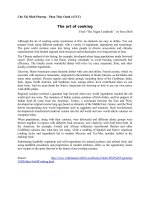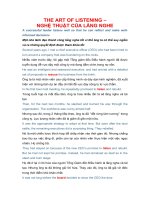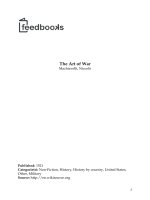live audio [electronic resource] the art of mixing a show
Bạn đang xem bản rút gọn của tài liệu. Xem và tải ngay bản đầy đủ của tài liệu tại đây (6.72 MB, 256 trang )
Live Audio
This page intentionally left blank
Live Audio
The Art of Mixing a Show
Amsterdam • Boston • Heidelberg • London • New York • Oxford • Paris • San Diego
San Francisco • Singapore • Sydney • Tokyo
Focal Press is an imprint of Elsevier
Dave Swallow
Focal Press is an imprint of Elsevier
30 Corporate Drive, Suite 400, Burlington, MA 01803, USA
The Boulevard, Langford Lane, Kidlington, Oxford, OX5 1GB, UK
Copyright
©
2011 Dave Swallow. Published by Elsevier Inc. All rights reserved
No part of this publication may be reproduced or transmitted in any form or by
any means, electronic or mechanical, including photocopying, recording, or any
information storage and retrieval system, without permission in writing from the
publisher. Details on how to seek permission, further information about the
Publisher’s permissions policies and our arrangements with organizations such
as the Copyright Clearance Center and the Copyright Licensing Agency, can be
found at our website: www.elsevier.com/permissions.
This book and the individual contributions contained in it are protected under
copyright by the Publisher (other than as may be noted herein).
Notices
Knowledge and best practice in this field are constantly changing. As new research
and experience broaden our understanding, changes in research methods, professional
practices, or medical treatment may become necessary.
Practitioners and researchers must always rely on their own experience and knowledge
in evaluating and using any information, methods, compounds, or experiments
described herein. In using such information or methods they should be mindful of
their own safety and the safety of others, including parties for whom they have a
professional responsibility.
To the fullest extent of the law, neither the Publisher nor the authors, contributors, or
editors, assume any liability for any injury and/or damage to persons or property as a
matter of products liability, negligence or otherwise, or from any use or operation of
any methods, products, instructions, or ideas contained in the material herein.
Library of Congress Cataloging-in-Publication Data
Application submitted
British Library Cataloguing-in-Publication Data
A catalogue record for this book is available from the British Library.
ISBN: 978-0-240-81604-3
10
11 12 13 5 4 3 2 1
Printed in the United States of America
For information on all Focal Press publications
visit our website at www.elsevierdirect.com
For Finn
This page intentionally left blank
vii
PRELUDE ix
INTRO xiii
SECTION 1
l
Pre Show
CHAPTER 1 What is a Live Audio Engineer? 3
CHAPTER 2 Audio Engineering Basics 7
CHAPTER 3 Electronics 27
CHAPTER 4 Power and Electricity 35
CHAPTER 5 Advancing the Show 41
CHAPTER 6 Rehearsals 53
SECTION 2
l
Show Day
CHAPTER 7 Load-In 65
CHAPTER 8 Public Address Systems 69
CHAPTER 9 Desks Up! 91
CHAPTER 10 Line Systems 129
CHAPTER 11 Acoustics 133
CHAPTER 12 Tune Up 145
CHAPTER 13 Stage Setup 157
CHAPTER 14 Soundcheck 183
CHAPTER 15 The Mix 195
CHAPTER 16 The Show 219
OUTRO 227
ACKNOWLEDGMENTS AND THANKS 231
INDEX 233
Contents
This page intentionally left blank
ix
Prelude
After leaving school at the age of 16, I didn’t really know what I was going to
do with my life. I knew I liked music; I’d been playing bass in a band since I
was about 14. I’d spent a lot of time taping live gigs off the radio, trying not to
get any talking, and I’d spent a lot of money buying gear and going to shows.
Meanwhile, my mate Mike had engineered my band for quite some time
and had shown me the ropes on the odd occasion. I must admit that I quite
enjoyed being behind the scenes.
I spent the summer after my last exams bumming around at a college study-
ing some bizarre computer course. That was fun, and I can still program
in Hexadecimal, but it’s pretty much useless to me these days. That summer
turned into a year, and by the following summer I’d found a sound engineer-
ing course up in London. It was only three days a week, and I managed to get
an interview. My mum smartened me up, gave me £20, and I headed off to
London town. After some normal questions about who I was, what I did, and
why I wanted to be a sound engineer, I was presented with the question that
would decide my fate: “Do you know what DI stands for?” At first I misheard
the question and started to tell the interviewer what it was used for—my career
as an engineer nearly ended there. Luckily for me, she repeated the question,
and my answer was good enough . . . I was in.
After being accepted for the course, I returned to my hometown of Southend-
on-Sea and went to the local PA firm, Maple Studios, which also owned the
local rehearsal studios, local venue, and eventually one of the local record-
ing studios; they gave me a job for the summer before I started college. I say
“job”—it was only three days a week, unpaid, and really only involved pushing
boxes around without trying to get in too many people’s way. It was the best
time of my life, and I made some lifelong friends that summer. (Maple Studios
is owned and run by my mentor, Glyn. This is where my understanding of all
things electronic and audible came from, and how I first got introduced to the
UK’s touring circuit.) After much pestering, I eventually started getting paid—
much to my parents’ relief.
After that summer, I persuaded Glyn to give me a job in addition to college,
and I followed up my practical experience at Chinnery’s, the local venue, with
what I was learning at college. In all honesty, college was a bit of a waste of
time for me—I learned more doing the job than sitting down listening to
someone talk about it. You need to bear in mind, though, that the program
I was enrolled in was geared more toward recording, and was, I believe, one
of only two or three of its kind in the whole country. It was very new, and not
Preludex
many people really knew how to teach the practical side particularly well. I sat
in countless classes with a pen and notebook taking notes. And there was me
thinking this was a practical job.
My parents, just like all parents, wanted me to be qualified for what I was
doing—so I stuck it out, even though I knew it was more about experience. So
that was three years of my life. I don’t regret any of it, though, because a lot of
the knowledge that I gained working in a freezing cold workshop at Maple in
the height of winter translated well into the electronics part of the course I was
learning at the time.
After college, I went back to work at Maple. My parents always wanted me to
get a proper job, but I knew I was doing serious work: There were a grave num-
ber of teenage Goths who needed their weekly dose of local ambiguous music,
and we were the only ones providing that fix. Slotted in between these local
events were some of the best smaller touring acts around, and because I was
working, I got to see them. This is where I really began to appreciate the differ-
ence between recorded and live music, and these were some of the best years of
my life.
One day, we got a phone call from the local theater: They had the Ted Heath
Orchestra with Dennis Lotis on vocals coming to town and had no one to mix
it. Off I went into the unknown world of theaterland, and some old guys I’ve
never even heard of. But when I told my dad, he knew who they were—and
ever since that day he’s approved of what I do . . . bless him.
After being in the local venue for a few years, one of the local bands, Engerica,
got a small record deal and was going on tour with another band, thisGIRL.
They asked if I could come along and mix for them, as I did such a smash-
ing job in Chinnery’s. So I went home and said, “Mum, Dad, I’m going on
tour”—and off I jolly well went. I slept on mates’ floors, in the backs of vans,
and once—at TJ’s in Newport, South Wales—we were allowed to sleep in
the upstairs apartment of the venue. This last one wasn’t as glamorous as it
seems—we weren’t allowed to turn on the gas fire, as it had been condemned.
This was a big tour for me: It was on this tour that I first met my now-old
chum Pablo (more on him in a minute), survived many breakdowns in the
van, experienced countless arguments—and I’m pretty sure it was the same
tour where my wallet and the drummer’s phone got stolen off a table next to a
window in my mate’s house in Leeds. Oh, how we laughed!
I met Pablo again when we were out on another tour; he was with the band
Kinesis, and I was with another of the Southend-based bands, Smother, which
was first on the bill. Winnebago Deal were on in the middle, great little band,
just a two-piece, and they were both called Ben. One of the Bens now works
at Oxford Academy, and it’s always a pleasure to see him. After that tour, I
decided to go it alone—so I gave my notice to Glyn, and off I went.
Prelude
xi
The following year, I was phoning around for some work and called Pablo.
He had just started working with a bunch of Welsh Rappers from Newport,
South Wales called Goldie Lookin Chain. They needed a monitor engineer, so I
jumped at the chance (and also because I didn’t have anything else to do at the
time). Suddenly, a couple of months later, they had a number one hit in the
UK charts: “Guns Don’t Kill People, Rappers Do.” The next thing I knew, we
were touring North America, Japan, and all over Europe, and playing the main
stages of some of the best and most prestigious festivals in the UK. I missed
my sister’s birthday that year because we were doing a show for Channel 4 on
a beach in the West Country—but as compensation for not being there, I got
the band to say “Happy Birthday” live on national TV while she was watching.
I think that did the trick.
So that’s me, and the story of how things got going. Most people who mix for
a living come from a background of playing instruments and then naturally
migrate toward the mixing console. But, as with almost anything, it’s really a
case of being in the right place at the right time and having the right attitude.
This page intentionally left blank
xiii
This book has been written on various modes of transport, four different con-
tinents, and I-can’t-remember-how-many countries over 2009 and 2010, while
on tour with the British artist La Roux.
Intro
FIGURE I.1
La Roux and Crew (from left to right, Paul Stoney (Backline), Colin Ross (Lighting Designer), Me (FOH), Risteard Cassidy (Monitors)
Elly Jackson (Vocals), Mickey O’Brien (Keys), Jess Jackson (Personal Assistant), Mike Norris (Keys), Mark Dempsey (Tour Manager),
William Bowerman (Drums).
Thanks, guys, for all your love and support.
Introxiv
BEFORE I BEGINNING…
It’s worth recalling where music comes from and why it came about. This
might not seem like the most obvious start to a book about live audio engi-
neering, but it’s an essential part of understanding what we do.
Music is extremely ancient; ever since humans first started communicat-
ing, rhythm and melody have helped tell stories about our past, present, and
future. There’s something very deep—spiritual even—about music, which I
suppose is why it has been around for so many thousands of years. Making
music and making musical instruments go hand in hand with this and has
been very important to our development as intelligent beings. The early pio-
neers of musical instruments would pull animal skins over bits of bone or
wood and tie various bits of leftover guts to branches.
Music is innate in all of us—it connects us and binds us together, in much the
same way that our ancestors would bond around fires. As an audio engineer,
you are responsible for making this modern-day fire. You are the musical mas-
ter of ceremonies. You are translating someone else’s emotional and spiritual
journey to the masses, and it is a big responsibility.
WHY THIS BOOK
Everything contained within these pages is something that I have come across
in my everyday life as live audio engineer, both in house and on tour. These
might not be everyday events, but they are certainly things that have expanded
my knowledge of the work I love and have found invaluable. The information
contained within these pages is what I’ve found most relevant from my college
experience, and what I’ve learned over the last 15 years of working and playing
in the music industry. Some people will have had different experiences than
myself—all I can say is that these are problems, solutions, and situations that I
come across every day when working for a professional, heavily touring artist.
Some information in the early stages of the book might come across as extremely
basic, and even irrelevant; but when we come back across these things later, you’ll
then understand why we’re discussing them. The aim is not to tell you what to
do, but rather how to think. The manipulation of sound isn’t something that can
be read or spoken about. It can be very instinctive, and getting out there and hear-
ing it for yourself is what really counts. Articles and textbooks can tell you how
to set up different things, but they never give you the room to discover sound for
yourself, which breeds creativity and knowledge, and which is so important in an
industry that is as much about technical know-how as it is about emotion.
HOW THE BOOK IS STRUCTURED
I’ve tried to make this book as relevant as possible by structuring the content
in a way that mirrors how live shows work. By reading this book, I hope to
help you not only understand the day-to-day life of a touring engineer, but also
some of the equipment and thought processes that we go through.
Intro
xv
The book is split into two sections: Pre-Show and Show Day. Everything I cover
in the Pre-Show section are things you must do or understand before heading
out on the road—for example, advancing a show and creating some kind of
stage infrastructure.
The Show Day section follows how a show runs in a normal touring scenario,
from the moment you turn up to the venue through the process of running
a sound check and the pitfalls of putting an audience in a venue. The aim of
this section is to talk through events as they happen in real time; for instance,
we talk about mics and their placement in Chapter 14. I hope it works in a
way that you get the information as you need it, and not have to retain lots of
information from previous chapters.
I hope this book comes across as a more real account of live audio, and I hope
it is an easy and enjoyable read—because, personally, I can’t stand reading
textbooks.
This page intentionally left blank
“For the past 32 years, I’ve done nothing outside the entertainment
business. I’ve had some real highs and some real lows, but I love the
work so much that I never once thought of quitting.”
—Meat Loaf
Pre Show
SECTION 1
This page intentionally left blank
3
Live Audio.
©
2011 Dave Swallow. Published by Elsevier Inc. All rights reserved.
2011
Job description: If you like semi-darkness, long hours of boredom, long
hours of work, no social life, no love life, heavy lifting, getting your white
gloves dirty, and a good laugh, this is the job for you.
Audio engineers, also known as sound engineers, come in many differ-
ent types: TV, radio, film, and live and recorded music, just to name a few.
Although these jobs are very different, the people who perform them are all
considered to be sound engineers. This holds true for other languages as well:
The Germans have different words for jobs such as tone master (Tonmeister)
and tone technician (Tonetechniker), the tone master being a producer and the
tone technician someone who operates the equipment.
This book is specifically about live engineers, whose job it is to look after the
sound at all types of live events. This can be a high-pressure job, as you only
get one chance to get it right. You need to be on the ball, understand when
things go wrong, and know where and how to fix them—quickly. In order to
help you do this job the best way it can be done, you must have general know-
ledge of all different aspects of the job.
In a live environment, there are three main types of audio engineers: front of
house, monitor, and system technician. In the following sections, we discuss all
of these types in more detail.
FRONT OF HOUSE (FOH) ENGINEERS
The front of house (FOH) is where the audience is, and an FOH engineer
mixes the audio for that audience. If all goes well, the FOH engineer is the per-
son standing in the middle of the audience next to the lighting guy and sur-
rounded by a barrier and different-colored lights. (The FOH engineer is often
mistaken for the DJ, but don’t even think about putting a request in.)
FOH engineers work hand in hand with monitor engineers and must have
good communication with them. Together, you must follow the band’s speci-
fications (see Chapter 5 on Advancing the Show). The FOH engineer also puts
the channel list together, thus ensuring that you have all the channels you need
What is a Live Audio
Engineer?
CHAPTER 1
SECTION 1
Pre Show
4
to mix the show to your liking. (Remember, though, that there might be some
channels that don’t need to be heard through the house speakers, such as click
channels and ambient mics for in ear monitors (IEMS).) Finally, the FOH engi-
neer also runs soundchecks.
Speaking from personal experience, I have spent some time doing this job,
and I always love it; being an FOH engineer gives me the ability to be creative
and loud at the same time. However, the mixing can be a challenge. It isn’t
just a case of pushing up your faders and making sound happen—it’s about
blending sounds into one another so that you hear a full mix with nothing
obscured. This is an enormous responsibility because you essentially have con-
trol of another artist’s music. Some artists really want to be involved with the
mix, while others might just let you get on with what you are doing. Either way
the ability to understand what the artist, management, or producer wants, and
then the ability to translate that into audio, is important. For example, if some-
one says “I want it to sound more raw,” or “More reverb!” you have to under-
stand what this means and how to do it. We’ll get into more detail about this
kind of thing in later sections.
MONITOR ENGINEERS
The job of a monitor engineer is probably the most fundamental of all the
live engineering jobs. Monitor engineers are responsible for controlling all the
sound on stage. Monitors are the speakers positioned on stage that allow per-
formers to be able to hear what’s going on. They are also referred to as wedges,
which is the term that most professionals use, or foldback, which is more of
an older term that isn’t particularly used from day to day. The majority of the
work for a monitor engineer is done during soundcheck, making sure that
everyone has what he or she needs to hear, and thus perform, well.
You will find the monitor engineer located just off to the side of the stage, pref-
erably on stage left (if room allows it). He or she controls the individual moni-
tor mixes for each of the performers on stage. As a result, it’s a good idea for
the monitor engineer to put the stage plan together, so that he knows where
all his monitors should be and what order the sends for the monitor console
need to be on. (We discuss stage plans in more detail in the Stage Plan section
in Chapter 5, where we go into more detail about why it’s a good idea for the
monitor engineer to do it. If there isn’t a monitor engineer, this responsibility
falls to the FOH engineer.) A monitor engineer might also be in charge of IEMs,
or in ear monitors. These are similar to headphone buds that can be molded
into shape. IEMs can also be generics, which are similar to foam earplugs with a
headphone attached to one side. There is a real art to mixing IEMs.
In order to be a monitor engineer, the performers must trust your work. This
can be a challenge, especially because you may be dealing with big egos. As
such, good communication skills are essential for doing a good job. Part of this
communication is understanding seemingly random hand signals and gestures.
What is a Live Audio Engineer?
CHAPTER 1
5
There is nothing quite like watching an artist wave his arms in the air, point at
objects, and nod his head as if some kind of epileptic fit has ensued—all in an
attempt to tell you that he requires a little more acoustic guitar in his wedge.
One of the basic rules of being a monitor engineer is to pay attention to the
performers at all times, looking at them even when they aren’t looking at you,
and constantly monitoring their individual mixes. Meanwhile, they’ll be able to
monitor each individual mix with their own wedge—called a listening wedge—
and their own set of IEMs. Make sure that the listening wedge is exactly the
same as the other wedges on stage, with the same amp and the same graphic
equalizers. Getting this part of the sound right is essential because performers
rely on you to get the best out of what they are doing.
The job of a monitor engineer is probably one of the hardest, but also one
of the most rewarding. There isn’t much room for creativity, but there is an
art form about getting monitor mixes right. When the performers have a great
show, the monitor engineer will have a great show.
SYSTEM TECHNICIANS
System technicians, also known as system techs, look after the whole PA system.
There are normally at least two system techs per PA system—one who looks
after the FOH and one who looks after monitors. These engineers are wholly
responsible for the entire PA system and usually have a vast knowledge of the
equipment they monitor; however, unlike FOH and monitor engineers, they
usually do not operate the equipment (unless asked to, or there isn’t anyone
else to do the job). Although most system techs will be able to mix, their main
responsibility is to make sure that all the equipment is working correctly and
is properly maintained. The biggest part of this job is to work with the artists’
FOH or monitor engineers to get exactly what they need out of the system and
equipment.
One type of system technician is also known as an in-house engineer. In-house
engineers have all the same knowledge as system technicians; the only differ-
ence is that they generally work for the venue, whereas system techs generally
work for PA companies.
THINGS TO THINK ABOUT
One of the important things for a sound engineer to realize is that it can
be quite a social job. You have to learn how to balance this out and realize
that you can’t simply leave your position to go enjoy the show or visit with
friends who are attending. Engineers are not part of the band, even though
they may spend a lot of time with them. You must remember that you are the
one who has to be in the venue before the band members, get things set up
before them, and stay behind after they have gone. Just remember: You are
there for a reason, and that reason is to mix. You are being paid to do that
and nothing else.
SECTION 1
Pre Show
6
Some engineers I know have next to no negotiation skills; their attitude is “It’s
either my way or the highway.” Try not to adopt this attitude when working—
it’s very important to be able to adapt to your surroundings. You are part of
a team that makes everything work, and it’s everyone’s job to make sure the
show happens and that the audience has a great time.
This industry is still very young and, as such, is constantly changing. Just
remember that if you want to make a career out of it, you must be profes-
sional, responsible, and courteous at all times. In addition, here’s a little tip for
when you’re on the road: You never know how someone else is dealing with
being away from loved ones, so you should always give people the benefit of
the doubt.
Above all, remember this: You are only as good as your last gig.
HOME LIFE
Your home life is one of the hardest aspects to navigate in this type of career.
Some people are built for travel, whereas others are made to stay in one place.
Some engineers get into this job because they are very attracted to the idea of
being able to see the world, even if only from the back seat of a taxi, or looking
out at a cityscape through a window in a departure lounge. However, having
a stable life at home is key not only to your own sanity, but also to the sanity
of the people around you. Being away from home can put a strain on even the
most solid of relationships, but the key ingredient for any type of relationship
is communication. With this type of job, having a family that understands who
you are, what you do, and why you do it is extremely important.
One of the difficulties of being a live engineer is getting outsiders to under-
stand what the job is like. Many people have incorrect preconceptions, espe-
cially due to the kinds of stories you hear about the early days of rock and roll.
These days, though, things are very different; usually you get straight on the
bus after a gig and head straight out of town. Going on tour is about making
money, which means you are always on the move.
Having troubles at home while you are away can lead to all sorts of problems.
It nearly always affects your work because your mind is constantly taken away
from the job at hand. As such, it can also affect the people you are working
with. Chemistry is crucial on the road, and a breakdown in trust and commu-
nication can be disastrous for the whole operation. Just remember, it is one
thing to talk about troubles, and another to take your troubles out on other
people. Take time for yourself. Everyone is in the same boat and will under-
stand if you don’t want to be part of group activities outside work time.
7
Live Audio.
©
2011 Dave Swallow. Published by Elsevier Inc. All rights reserved.
2011
If you want to be a sound engineer, you must have a good understanding of all
the elements that affect the job. This section explains these elements.
THE EAR
Your ears are one of the only senses that aren’t ever turned off. You can close
your eyes and stop touching things, but your brain is always processing
audio. According to certain studies, audio frequencies affect brainwaves; for
example, the complex patterns of Beethoven’s music stimulate the brain and
thus improve thought processes, helping you to retain more information.
Although it’s hard to vouch for this personally, many people will tell you
that they have strong reactions to music they hear—perhaps even a built-in
passion. What is clear is that music does affect the way we think. For exam-
ple, in my personal experience, the simpler the music being listened to, the
easier it is to relax, whereas the more intricate the music is, the more stimu-
lated I feel.
Sound can be an incredibly powerful sense, and not only for animals who
“see” using sonar, such as dolphins and bats. In Dorset, United Kingdom,
there is a 7-year-old blind boy who navigates using a series of clicks. The tech-
nique is called echolocation and was developed in California; it is based on
the Doppler effect, which is the principle stating that when an object is mov-
ing away from you, it creates a lower pitch, and when it is moving closer to
you, it creates a higher pitch. For example, when a police car goes speeding
past, you’ll hear the frequency of the siren change. Using this knowledge, and
with much practice, practitioners of echolocation can determine the height,
width, and location of specific objects; in some cases, they can even guess
their density. Objects that are closer, larger, and simpler are easier to perceive.
A technique like this shows us how we can use and harness the power of
frequencies, and how important it is to look after our hearing. It also says
a lot about what can be achieved using audio and how important it is for
everything we do.
Audio Engineering Basics
CHAPTER 2
SECTION 1
Pre Show
8
Do We All Hear the Same?
The simple answer to this question is no. It’s not that our ears work differently;
rather, due to a number of factors such as ear size and damage, the frequency
ranges each person hears vary slightly. If you are right-handed and have been a
drummer all your life, for example, you might notice that, in your left ear, you
may not hear 1.5 kHz very well. This is likely because of your snare drum. Your
perception of sound also depends on how you listen. Have you ever heard an
album and thought, for example, that the cymbals sounded great—but then
learned that others disagree? This is because listening is, to some extent, depen-
dent on experience. You can train yourself to listen to different things, either
individually or collectively. As an audio engineer, you need to separate and sort
sounds in your head, and you also need to determine from which direction
they are coming.
How Do Ears Work?
The ear consists of three parts: the outer ear, the middle ear, and the inner ear.
When you first hear sound, the pinna (which is the name for the outer ear) cap-
tures the sound and funnels it into the ear canal; then, once it travels through
the ear canal, the sound reaches the eardrum, which is the border between
the outer and middle ear. The middle ear consists of three bones, collectively
FIGURE 2.1
The ear.









